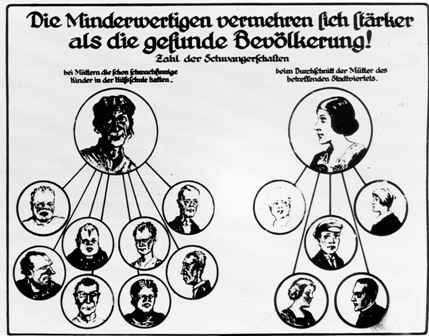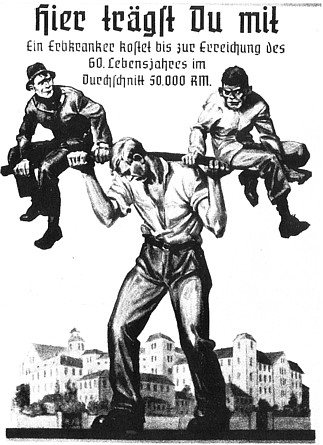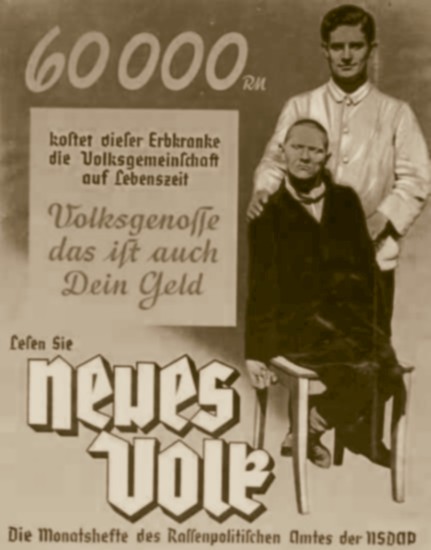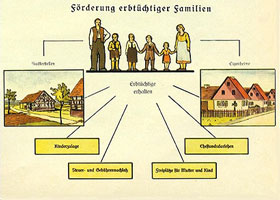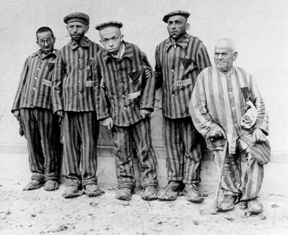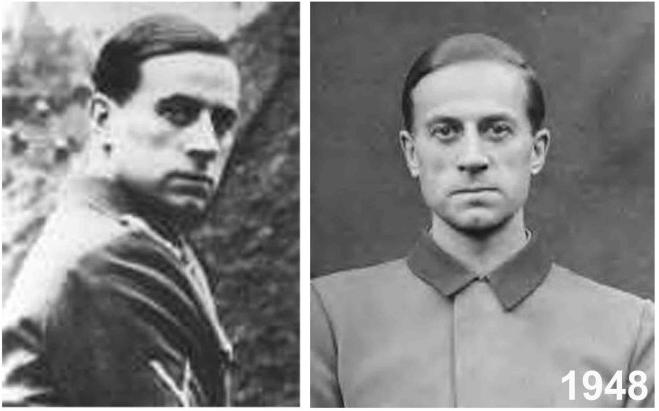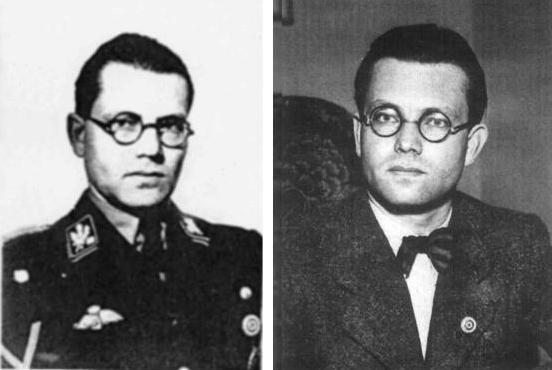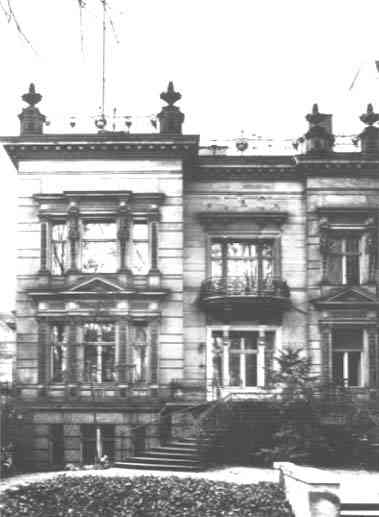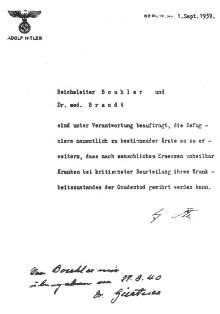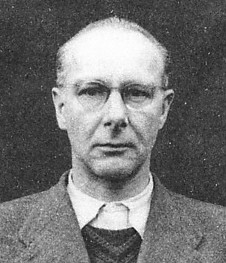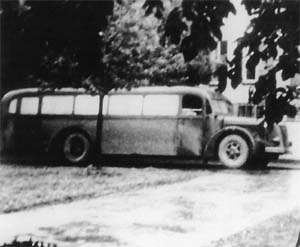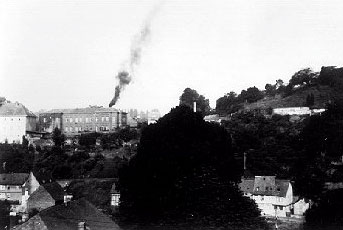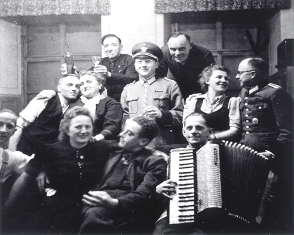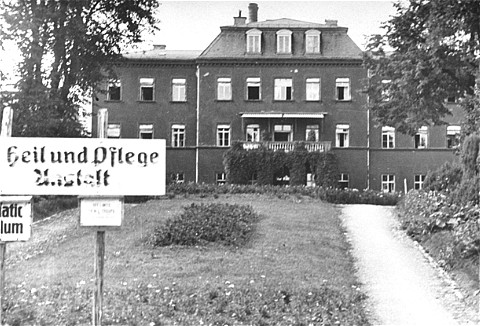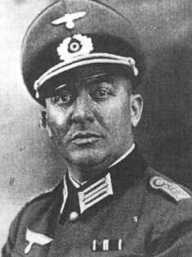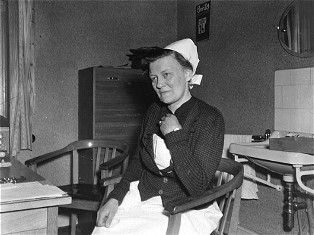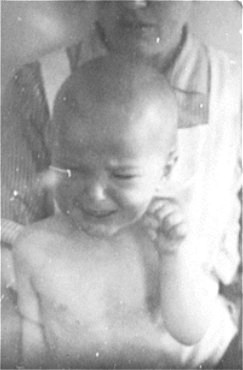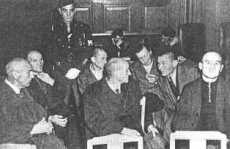Holocaust Education & Archive Research Team |
Euthanasia
Nazi Eugenics & Euthanasia T- 4 Staff T- 4 in Poland T - 4 in Germany & Austria
| ||||||||||
Introduction To Nazi Euthanasia
The Shorter Oxford English Dictionary defines euthanasia as “the action of inducing a quiet and easy death.” This grant of a “mercy death” may occur with the consent of the individual concerned, is then termed “voluntary” “euthanasia” and was the meaning originally given to the word. However, euthanasia also came to be termed “involuntary”, as for example when a patient is suffering from an incurable and painful disease, or is in a coma and is considered unlikely to regain consciousness. In such circumstances, a third party or parties may determine to put an end to the patient’s suffering. The circumstances are, in general, that the person involved is no longer capable of making up his or her mind and/or to express his or her ultimate wish. But Nazi ““euthanasia”” was quite different in conception and practice from the dictionary definition, old or new. For it was derived, not from humanitarian or compassionate reasoning, but from pseudo-scientific theory and ruthless economic policy. The Nazis destroyed “life unworthy of life” (lebensunwertes Leben) as they termed it, not as an act of mercy, but as part of a strategy to murder that part of the population least able to defend itself. That policy was directed not only at German citizens, but at those of other eastern European countries which fell under Nazi hegemony, particularly Poland. The ““euthanasia”” programme formed an essential part of the evolving Nazi policy of extermination on a massive scale. That policy reached its apogee with the murder of the Jews, but had the programme arrived at its intended conclusion, the eventual death toll would have been immeasurably greater. The Nazis did not create this twisted version of euthanasia. Its roots lay in a selective reading of the evolutionary theories of Charles Darwin, and the distorted “scientific” thinking to which this gave birth. The term "eugenics", a thesis which has no scientific basis, was coined in 1881 by the British naturalist and mathematician Francis Galton. It was described as "the science of the improvement of the human race by better breeding." This took the concept of “survival of the fittest”, a fundamental element of Nazi ideology, to its logical conclusion. Eugenics developed within the larger movement of Social Darwinism, which applied Darwin's "struggle for survival" to human affairs. The fundamental tenet of the eugenics movement was that restricting the ability of “inferior” people to procreate whilst maximizing that of “superior” individuals, would benefit society. Attention was focused on the feebleminded (an inaccurate term covering everything from mental retardation to alcoholism), labelled as idiots, imbeciles, or morons. It was suggested that there existed a relationship between low intelligence and both immorality and crime.
The cause of the social problems of the time was deemed to be inherited feeblemindedness and the resulting poverty by hereditary degeneracy. It was concluded "Not all criminals are feebleminded, but all feeble-minded persons are at least potential criminals. That every feeble-minded woman is a potential prostitute would hardly be disputed by anyone." Racism too, was not far from the minds of the eugenicists. The "darker peoples of southern Europe and the Slavs of eastern Europe are less intelligent than the fair peoples of western and northern Europe" wrote one, adding that the "Negro lies at the bottom of the scale" of intelligence. Harry Hamilton Laughlin, director of the Eugenics Record Office in the United States, compared” human racial crossing with mongrelisation in the animal world" and argued that "immigrants from southern and eastern Europe, especially Jews, were racially so different from, and genetically so inferior to, the current American population that any racial mixture would be deleterious." The eugenics movement was international, (the world’s first professorial chair in eugenics was established in 1909 at University College London), but was particularly influential in Germany, where in his 1895 book, “The Right to Death” (Das Recht auf den Tod), Adolf Jost argued that if the state demanded the sacrifice of thousands of individuals in wartime, it had the same “right” in times of peace to demand the sacrifice of the impaired and non-productive, who were draining the state of its resources. Twenty five years later in a book entitled “The Permission to Destroy Life Unworthy of Life” (Die Freigabe der Vernichtung lebensunwerten Leben), Karl Binding and Alfred Hoche proposed that “unworthy life” included not only the incurably sick, but many of the mentally ill and feebleminded, as well as retarded and deformed children. Killing such people was “an allowable, useful act.” To the eugenicists, such people appeared to have less intelligence, higher levels of antisocial behaviour, and, accordingly, less human value than worthier individuals, such as, naturally, the eugenicists themselves. They were “burdensome existences” (Ballastexistenzen). For Binding and Hoche, the right to live was not an entitlement but was to be earned, and it was earned by being a useful economic contributor to society. Writing of those with disabilities, and advocating “involuntary euthanasia”, they continued: “Their life is absolutely pointless, but they do not regard it as being unbearable. They are a terrible, heavy burden upon their relatives and society as a whole. Their death would not create even the smallest gap--except perhaps in the feelings of their mothers or loyal nurses.” The unimaginable had occurred; physicians were being encouraged, not to save life, but to take it. Against such a background of pernicious nonsense masquerading as legitimate scholarly research, it is hardly surprising that Adolf Hitler became an early and enthusiastic supporter of this ““euthanasia”.” In Germany the term "Race Hygiene" was in use long before the label of “eugenics” became common, and the German Society for Race Hygiene (Deutsche Gesellschaft für Rassenhygiene) was to eventually represent all eugenicists. In 1931, two years before Hitler’s assumption of power, Fritz Lenz, professor of race hygiene at the University of Munich, declared: "Hitler is the first politician with truly wide influence who has recognized that the central mission of all politics is race hygiene and who will actively support this mission." And support it he did. In 1934 Ernst Rüdin, psychiatrist and author of the 1933 Nazi sterilization law stated: "The psychiatrist and the healthy person are allies against the genetically defective. The psychiatrist must render his service to the ultimate aim of a hereditary pure, able and superior race." It took Samuel Beckett to point out the irony in this Nazi obsession with the creation of a race of “supermen.” An `Aryan’, he wrote, must be blonde like Hitler, thin like Göring, handsome like Goebbels, virile like Röhm – and be named Rosenberg. At the 1929 party rally, Hitler had suggested that countless lives could be eliminated by racial measures:
“If Germany was to get a million children a year and was to remove 700-800,000 of the weakest people, then the final result might even be an increase in strength. The most dangerous thing is for us to cut off the natural process of selection and thereby rob ourselves of the possibility of acquiring able people. The first born are not always the most talented or strongest people… As a result of our modern humanitarianism we are trying to maintain the weak at the expense of the healthy.” After attaining power in 1933, the Nazis began an extensive propaganda campaign with the object of acquainting the German people with the benefits of ““euthanasia”.” Via newspapers and magazines, radio and film, the suggestion was made that life could be so much better for the productive many if the non-productive few, who were such a burden to the nation, were simply eliminated. Would it not be better for them if an end was put to their misery and suffering? But the road to state sanctioned murder was to be a gradual one. With the early introduction of legislation (the 'Law for the Restoration of the Professional Civil Service' of 7 April 1933), the Nazis thoroughly purged long-established ethical and administrative public supervisory bodies. Less than 6 months after his election in 1933, Hitler introduced the “Law for the Prevention of Genetically Diseased Offspring.” It decreed compulsory sterilization for persons characterized by a wide variety of disabilities. It has been estimated that by 1939, 200,000-350,000 persons had been sterilized, many of whom subsequently became victims of the ““euthanasia”” programme. In the same year the Nazis enacted the “Law Against Dangerous Habitual Criminals”, which further blurred the distinction between actual criminal behaviour and the inappropriate social behaviour that characterized many people with disabilities. The law stipulated that these criminal asocials (asozialen) could be committed to state asylums, held in indeterminate protective custody, and, in the case of sex offenders, officially castrated. These and other laws prepared the ground for the Nürnberg Laws of 1935, which, while directed primarily at Jews, also regulated marriage among people with disabilities. For example, the “Marriage Health Law” prohibited marriage between two people if either party suffered from some form of mental disability, had a "hereditary disease" as previously defined by law, or suffered from a contagious disease, particularly tuberculosis or venereal disease. By that time Hitler was already proposing that he would use the cover of war to murder psychiatric patients in fulfilment of a long-held belief that he had expressed in Mein Kampf. The war, Hitler reasoned, would provide both a distraction and an excuse for officially killing those deemed undesirable. If war should break out, he informed Gerhard Wagner, he would take up the ““euthanasia”” question and implement it. By the end of 1938, the regime was receiving requests from the families of newborn or very young children with severe deformities and brain damage for the grant of a “mercy killing” (Gnadentod). In particular, a petition was received in respect of an infant named Gerhard Herbert Kretschmar, the so-called `Knauer’ child, who had been born on 20 February 1939, blind, with one leg and part of one arm missing, and who was described as an “idiot.” Hitler ordered Karl Brandt, his personal physician, to visit the child in a hospital at Leipzig. Brandt testified at his post-war Nürnberg trial he had been instructed that if the facts provided by the child’s father proved to be correct, he was to inform the physicians in Hitler’s name that ““euthanasia”” could be carried out – which it was, on 25 July 1939. It is arguable that the `Knauer’ case was the catalyst for all that followed, although it could equally be argued that Hitler’s dedication to ““euthanasia”” was such that its introduction was inevitable at some point in the mercifully brief history of National Socialism. On his return to Berlin, Brandt was authorized by Hitler to proceed in the same fashion with similar cases. Hitler did not wish to be publicly associated with what even he considered to be a delicate matter, and so Brandt was ordered to secretly organize a programme with the aid of Philip Bouhler, head of the Chancellery of the Führer (KdF: Kanzlei des Führer der NSDAP), an agency created by Hitler in 1934, ostensibly to keep him in direct touch with the concerns of the population, but acting in practice as Hitler’s private office. Under the direction of Bouhler, the KdF was to acquire a more sinister purpose, for it was to be the conduit through which first the ““euthanasia”” programme and subsequently the planned mass extermination of Jews and others was to operate. Answerable to nobody except Hitler, in 1939 Bouhler seized the opportunity to acquire authorisation to administer the ““euthanasia”” programme through his deputy, Viktor Brack.
In May 1939, Hitler had instructed Brandt to pave the way for the killing of children by setting up a body entitled the `Reich Committee for the Scientific Registering of Serious Hereditary and Congenital Illnesses’. By a decree dated 18 August 1939, doctors and midwives were ordered to report all cases of “deformed” newborn. Even before war came in September 1939, the Nazis had thus established a government sanctioned process for murder. Two laymen made a preliminary selection of cases, which was then reviewed by three medical professors who determined the fate of the child. If selected for ““euthanasia””, the child was transferred to one of a list of special hospital wards for killing. As early as July 1939, Werner Heyde, who was to play a prominent role in the ““euthanasia”” programme, attended a meeting at which he learned of the imminent killing of the adult mentally ill. As with the `Final Solution’, ““euthanasia”” provided a perfect confluence of the two essential elements of National Socialist ideology – the biological and the economic. A hospital director, Ludwig Schaich reported: “When it became increasingly apparent, in the final years before 1939, that war was imminent, we learned that there had been discussion in the Reich Ministry of the Interior about putting the inmates of hospitals and nursing homes for the mentally ill, the mentally deficient and epileptics on drastically reduced rations in the event of war. When we objected that this would mean condemning our patients to a slow but certain death by starvation, they carefully began to sound out how the Home Mission would react if the state were to contemplate the elimination of certain categories of sick person in wartime, given that food supplies, once imports dried up, would no longer suffice to feed the entire population.” In a report prepared for Hitler in the summer of 1939, another of his personal physicians, Dr Theodore Morell, having reviewed a survey carried out in the 1920s of the parents of severely handicapped children, wrote: “A number of parents expressed the view: `If only you had done it (i.e., ““euthanasia””) and then told us that our child had died from an illness.’ There is a lesson for us there. We need not suppose that we cannot carry out any salutary measure without the consent of the sovereign people.” It was clear that the regime could expect no great negative reaction to the programme from the general populace. A survey conducted in April 1941 revealed that 80% of the relatives of those murdered by the programme were in agreement with the decision, 10% spoke out against it, and 10% were indifferent. It has been suggested that this policy of `official secrecy’, where people knew while pretending not to know, and only a very few protested, was an invitation to denial and moral indifference on the part of both the German establishment and the German nation as a whole. It laid the foundation for a similar reaction to the `Final Solution.’ If people did not protest at the murder of their own relatives, they were hardly likely to do so when Jews, Gypsies, and foreigners were slaughtered. Although Hitler had already given verbal authorisation to the “euthanasia” enthusiasts, he wished to avoid the passing of an official law. However, he was pressed to confirm his instructions. In a dictatorship, no debate was necessary, no act of government required. It was enough for Hitler to simply issue a command (rarely explicit, and even more infrequently in writing) for his wishes to attain the force of law. And so, in October 1939, a brief decree was issued on Hitler’s private stationery and signed by him:
“Reich Leader Bouhler and Dr Brandt are charges with the responsibility for expanding the authority of physicians, to be designated by name, to the end that patients considered incurable according to the best available human judgement of their state of health, can be granted a mercy death. [Reichsleiter Bouhler und Dr. med. Brandt sind unter Verantwortung beauftragt, die Befugnisse namentlich zu bestimmender Ärzte so zu erweitern, dass nach menschlichen Ermessen unheilbar Kranken bei kritischster Beurteilung ihres Krankheitszustandes der Gnadentod gewährt werden kann.]) Those responsible for subsequent events later drew up several bills that would have made ““euthanasia”” legal, but these were rejected by Hitler. He believed (almost certainly correctly) that this would present an unacceptable propaganda opportunity to the enemy. It was necessary to wait until final victory had been achieved before passing such a law. The decree was backdated to 1 September 1939 to coincide with the date of commencement of the Second World War. After operating from a number of different addresses, a permanent headquarters for the new organization was established at Tiergartenstrasse 4 in Berlin. The premises were rented by the KdF in early 1940 under the name of the`Reich Work Group of Sanatoria and Nursing Homes’ (Reichsarbeitsgemeinschaft Heil- und Pflegeanstalten: RAG). The organization’s code name, T4, was taken from this address. Other dummy organisations were set up under seemingly innocuous titles – the `Charitable Foundation for Institutional Care’ (Gemeinnützige Stiftung für Anstaltspflege: Stiftung ), the `Charitable Society for the Transportation of the Sick Limited’ ('Gemeinnütziger Krankentransport GmbH': Gekrat), the `Central Compensation Office for Sanatoria and Nursing Homes (Zentralverrechnungsstelle Heil- und Pflegeanstalten: ZVST).’ These names were all intended to camouflage the true purpose of the murderous plan. The ultimate authority for the ““euthanasia”” operation was Hauptamt II (Main Office II) of the KdF, headed by Viktor Brack. It was the decision-making agency for all aspects of the “euthanasia” and subsequent Aktion Reinhard policies. Although Bouhler was titular head of the whole operation, in fact he had little to with it unless his authority was needed in dealing with other government agencies. Brandt dealt only with the medical aspect of the operation, and continued to run his medical practice. Heinrich Lammers was head of the Reich Chancellery and constantly carped about the lack of a legally proclaimed decree for “euthanasia”, something Hitler absolutely refused to do. Martin Bormann, head of the Party Chancellery, was kept well away from “euthanasia” matters because it was well-known at the KdF that in his hands “euthanasia would not stop at mental patients.” He was displeased at being excluded because his brother Albert worked for the KdF and was also one of Hitler's adjutants. Brack's deputy was Werner Blankenburg; Hefelmann was the leading light at the Kdf for children's “euthanasia”. All the KdF staff involved in “euthanasia” took the job on in addition to their normal functions, and all were completely immersed in the business of murder. Individuals recruited for the project were asked if they were prepared to participate. None were coerced. Doctors were never ordered to kill psychiatric patients and handicapped children. However, all participants were required to confirm, by one means or another, their understanding of the necessity to maintain absolute secrecy. Some were told that a ““euthanasia”” law existed, but could not be shown to them for the same reason of secrecy. Few of those approached declined an invitation to become involved. It was possible to refuse to participate in killing, or to end one’s participation, as some did. So far as is known, nobody was executed or sent to a concentration camp for doing so. All the T4 staff were initially interviewed by Brack or Blankenburg, “even down to the tea-ladies.” The recruitment of Dieter Allers may be regarded as typical. In 1939, Allers, a young lawyer, was sent to Poland as an army training sergeant. In November 1940, his mother met Blankenburg in the street and when she told him that her son was in the army, Blankenburg offered to give him a job at the KdF and arranged for his discharge from the military. In January 1941, Allers was appointed managing director of T4 by Brack. “Find men with courage to implement”, and “nerves to endure” was mentioned in a speech by Brack on 23 April 1941. Judging from their backgrounds, the majority of lower echelon staff recruited to the program were of average intelligence with a basic standard of education. They lacked the attributes or inclination to become members of the SS or the police. The overall impression obtained from their personnel backgrounds was that they were initially surprised at being selected as none had applied to join T4; they were summoned and had no idea why, nor what they would be doing. They were mostly employed at jobs such as doormen, telephone operators, and general handymen and were gradually inveigled into the actual killing process. There were, of course, exceptions to whom killing came naturally, but in general the KdF, through their representative Christian Wirth, bred a team of specialist murderers who could kill without any qualms of conscience or, if they were troubled, continued to kill anyway. The later hands-on, practical killers of European Jewry came predominantly from this “euthanasia” cadre of `ordinary men’: chefs, carpenters, drivers, plumbers, photographers, and nurses.
Even before the issue of the edict, the killing of Polish patients had begun in what were to become the incorporated territories of Danzig-West Prussia and the Warthegau, as well as that of German patients in Pomerania and East Prussia. The units involved were the Eimann commando, Einsatzkommando 16 and the Selbstschutz (a paramilitary organization of Volksdeutsche). The Eimann commando, or Volksdeutsche SS-Sturmbann E, was named after SS-Obersturmbannführer Kurt Eimann, who was from Görlitz. In autumn 1939 the Sturmbann was ordered to kill 1,400 patients from Pomerania in the wood of Piasnitz near Neustadt in West-Prussia (today, woods close to the Piasnica River, near Wejherowo). On 22 September 1939, the Eimann commando began killing 2,000 Polish patients in the mental hospital at Konradstein (today Kocborowo), south of Danzig (Gdansk.) In the following months, thousands of Polish mental patients were killed. Initially executions were by shooting, but in October, Dr Albert Widmann, chief chemist of the Kripo (Criminal Police) suggested the use of bottled carbon monoxide as a killing agent. The first gas chambers were being constructed at Grafeneck and Brandenburg in late November. By that time gassing experiments on mental patients utilizing both carbon monoxide and an agent similar to Zyklon B had already taken place at Fort VII in Posen (Poznan.) Eimann was sent to the SS-Standortkommandantur at Lublin on 20 November 1941. By January 1940, Polish patients were being gassed, not in stationary gas chambers, but in mobile gas vans; bottled carbon monoxide was introduced into a sealed compartment at the rear of the vehicle. The first of these vans was operated by a commando headed by Herbert Lange, formerly the chief of staff of Naumann’s Einsatzgruppe VI. Throughout the first months of that year, Lange’s commando travelled around the Warthegau in a van bearing a sign advertising `Kaiser’s Kaffeegeschäft’ (Kaiser’s Coffee Company). The commando also journeyed to East Prussia, where in a period of less than three weeks more than 1,800 German and Polish patients were gassed. It has been estimated that a total of 7,700 sick and handicapped patients fell victim to this early, experimental killing phase. Following the invasion of the former Soviet Union in 1941, many more mentally ill patients were murdered in places such as Riga, Dvinsk, Aglona, Poltava, Mogilev, Kiev, and so on. During the first two years of the war, the ““euthanasia”” programme in the Reich entered four distinctive but overlapping phases, relating sequentially to the killing of infants, adults, institutionalised Jews and concentration camp prisoners. 22 -28 special wards were established in hospitals throughout the country for the murder of children. In time, this programme was extended from infants to older children, and in some cases even to teenagers. By the end of the war, approximately 5,000 children had been killed. A visitor to the Reich Committee institution at Eglfing-Haar described the cynicism with which the director, Dr Hermann Pfannmüller, boasted of his methods, openly admitting that among the children to be murdered were some who were not mentally ill. They were simply the children of Jewish parents. “No Jews are allowed in my institution!” Pfannmüller proudly declared. The strategy for adult “euthanasia” was much more comprehensive. The Interior Ministry had issued another decree on 21 September 1939, requiring medical facilities to complete a questionnaire in respect of all patients who (a) suffered from an extensive list of medical conditions and were unable to work; or (b) had been institutionalized for more than five years; or (c) had been committed as criminally insane: or (d) were non-`Aryan’. As with children, whether or not an individual was condemned to die was supposedly decided by a panel of physicians. That was by no means always the case. Dr Rudolph Boeckh, head physician of the asylum at Neuendettelsau, protested at the manner in which the medical commission had behaved at his establishment: “… The commission did not examine one single patient out of the 1,800 concerned… They merely questioned the nursing staff, whose opinions were recorded on the forms… Cases were observed in which the opposite of the staff member’s true statement was recorded on the questionnaire…” Not all doctors were prepared to become part of the nefarious plan, although there was often a disquieting acceptance of the principle involved. When approached to become head of the children’s “euthanasia” programme at Eglfing-Haar by the aforementioned Pfannmüller, Dr Friedrich Hölzel declined, writing: “… It is one thing to approve of measures of the state with full conviction, and another to carry them out oneself in their final consequences. I am reminded of the difference which exists between a judge and an executioner…” But in general, the medical establishment was deeply implicated in the “euthanasia” programme. Heinrich Bunke gave the following explanation for accepting the invitation to join T4 as a physician : "It provided the opportunity to collaborate with experienced professors, to do scientific work, and to complete my education [Ausbildung]."
By the late 1930s, the regional health departments and administrators of the psychiatric institutions had been completely taken over by Party officials who used their political affiliation to browbeat those who remained non-political. During the T4 “euthanasia” phase at the Eichberg Institution - which also provided victims for the Hadamar killing centre - Dr Walter Schmidt, a fanatical Nazi bureaucrat, strutted around in SS uniform with pistol at his side supervising the daily murder of patients. Schmidt, described by one male nurse as a “hothead and psychopath,” gave orders to his nurses to shoot dead any patient who attempted to escape. The non-medical middle managers, often recruited from the police, were motivated by personal considerations of advancement and ideological commitment; they were the arbiters of life and death. Unlike the children, who had been murdered in the main by lethal doses of medication or starvation, the much greater number of adults to be liquidated demanded a more efficient killing system. Following Dr Widmann’s expert advice and the experience gained at Posen, it was decided to use bottled carbon monoxide in stationary gas chambers situated in six killing centres - Grafeneck, Brandenburg, Bernburg, Hadamar, Hartheim and Pirna-Sonnenstein (only four of which were in operation at any given time.) Each killing centre was assigned a code that was to be used in all telephone conversations and written communications with the T4 central offices: "A" was assigned to Grafeneck, "B" to Brandenburg, "C" to Hartheim, "D" to Sonnenstein, "Be" to Bernburg and "E" to Hadamar. An experimental gassing was carried out at the former Brandenburg-Havel prison in either December 1939 or at the beginning of January 1940. Among those present were Drs Horst Schumann (later director of Grafeneck and then Sonnenstein, subsequently notorious for his medical experiments on prisoners at Auschwitz), and Irmfried Eberl (later director of Brandenburg and subsequently first Commandant of Treblinka.) 18-20 asylum inmates were herded into a rudimentary gas chamber which had been constructed under the supervision of Christian Wirth, a name which was to loom large in events to come. The onlookers watched closely as the inmates died from carbon monoxide poisoning. 4-6 further inmates were administered lethal injections, but when the poison had little immediate effect, these inmates were also gassed. The experiment was considered a success. Gekrat, was created to ship the victims by bus to the killing centres. A fleet of buses (usually three at each killing centre) was hired from the Reich Post Office. The Gekrat bus drivers were all SS-NCOs recruited from the concentration camps. The gas was supplied by the Ludwigshafen plant of I G Farben (today Badische Anilinund Sodafabriken: BASF) to the KdF, who traded under the name “Jennerwein” (Brack) and “Brenner” (Blankenburg). From the autumn of 1940, in order to maintain secrecy, patients were no longer transferred direct to the killing centres, but were first taken to transit institutions. Most of the deceptive practices that were later used in the death camps in Poland were first in evidence in the ““euthanasia”” programme. For example, at Hadamar, only minutes before they were taken to the gas chamber, the victims were given a stamped postcard on which to report to relatives a safe arrival at their destination. A similar killing method applied in all of the centres. At his trial at Nürnberg, Viktor Brack had described the simple design of the gas chambers : "No special gas chambers were built. A room suitable in the planning of the hospital was used, a room attached to the reception ward.... That was made into a gas chamber. It was sealed, it was given special doors and windows, and then a few metres of gas pipe were laid, some kind of pipe with holes in it. Outside of this room there was a bottle, a compressed bottle, with the necessary apparatus, necessary instruments, a pressure gauge, etc." Apparently, it was Bouhler who suggested that the gas chamber at Brandenburg should be disguised as a shower room, a deception that was to become a common feature of Nazi killing centres.The gas chambers were approximately 3m x 5m x 3m high. Benches lined the walls, hiding a 3cm perforated pipe that encircled the chamber. Usually in batches of 40-60 at a time, the patients were told they were to enter this "inhalation room" for therapeutic reasons. Troublesome or resistant patients were sedated or manhandled into the chamber by brute force. Initially, in accordance with orders from the KdF, the gassing apparatus was operated by the medical director at each ““euthanasia”” institution, who became known as the Vergasungsarzt ('gassing doctor'.) Within 5 minutes, the victims were unconscious, and within 10 to 15 minutes, all were dead. After a wait of approximately 1 hour, the chamber was ventilated and the bodies were transferred either to the autopsy room or to the crematorium for incineration. Prior to cremation, however, the bodies were plundered. Gold-filled teeth and dental bridges were broken from the corpses' mouths for smelting. Organs, especially fresh brains, were collected at autopsies. The brains were processed by the Kaiser-Wilhelm-Institute of Neurological Research in Berlin and the Kaiser-Wilhelm-Institute of Psychiatry in Munich (today the Max-Planck-Institutes). Not all bodies of children had been immediately cremated. Autopsies were conducted on some in the interests of "science" by doctors attempting to find causes for the child's disability. Autopsy activities of this kind provided experience for novice surgeons, who often received academic credit for their efforts. As in the death camps which were to follow, the logistical problems of burning the bodies far outweighed the relatively simple killing method. Between two and eight bodies were cremated at a time. After cremation, residual bone was crushed in mills or by mallets on specially constructed worktables. Each killing centre had a so-called special registry office, from where a standard falsified death certificate and letter of condolence were sent to victim’s next-of-kin.
A list of causes that could explain a sudden natural death was available. Relatives were informed that it had been necessary to cremate the body for public health reasons; the ashes of the deceased were available upon request. Nazi functionaries and German bureaucrats were stereotypically precise and efficient when it came to keeping records about mass murder. Originals or copies of all paperwork generated by the killing program were retained, including record books and lists for internal T4 use, correspondence with outsiders, and the medical records of the killed patients. To organize the paperwork, each killing centre kept a death book (Sterbebuch), sometimes known as the book of patients (Krankenbuch). In the midst of this carnage, local authority representatives convened on 3 April 1940. The main speaker at this gathering was Viktor Brack. According to the notes of one of those present at the meeting, Brack was explicit about the social and economic benefits of “euthanasia”: “In many hospitals and nursing homes of the Reich there are countless people with incurable diseases of every kind, people who are of no use at all to the rest of humanity, who are only a burden on society, incurring endless costs for their maintenance, and there is absolutely no prospect of these people ever recovering and becoming useful members of society again. They sit and vegetate like animals, they are social misfits undeserving of life – and yet physically they are perfectly healthy human beings who may well live on for many more years. They eat the food that could be given to others, and in many cases they need twice or three times as much nursing care. The rest of society needs to be protected against these people. Given that we need to make provision now for keeping healthy people alive, it is all the more necessary to get rid of these creatures first, even if only to take better care for now of the curable patients in our hospitals and nursing homes. The space thus freed up is needed for all kinds of things essential to the war effort: military hospitals, civilian hospitals and auxiliary hospitals.” On 9 October 1939, a meeting of the organisers of the programme had been held, at which a formula was presented by which the number of future potential Reich “euthanasia” victims could be calculated. The basis of the calculation was the ratio 1,000:10:5:1, meaning that for every 1,000 of the population, ten would require psychiatric treatment. Of those requiring treatment, five would receive this as in-patients, and one of those in-patients would fall within the scope of the programme. That is to say, one in every 1,000 of the population would be subject to ““euthanasia”.” Applying this ratio to the population of the Reich as a whole resulted in an aggregate figure of 65,000 -70,000 potential victims. This figure proved to be an under-estimate. In 1942, the statistician Edmund Brandt (one of many bureaucrats to find employment with the post-war West German government) prepared an analysis entitled “What has so far been accomplished by the various institutions in terms of disinfection?” The “institutions” were the six principle killing centres (it has been estimated that there were more than 100 such establishments overall.) “Disinfection” was a code word for murder. By Brandt’s calculations, between January 1940 and August 1941, when the killings were officially suspended, precisely 70,273 patients had been murdered by gassing. Brandt went on to calculate the savings made in food, clothing and accommodation on the assumption that those murdered had been allowed to survive for a further ten years. Based on the average daily needs for an institutional inmate, he estimated that the killing of these sick persons, incapable of labour – “useless mouths” in Nazi terminology – would yield precisely 885,439,800 Reichsmarks in savings by 1951. It has been calculated that as many as 33% of the beds occupied by the mentally sick in the pre-war period had been made available through “euthanasia.” At least 20,000 further victims had been killed by that time by means of lethal injection. In fact, despite a pause, the killing in various guises continued until the end of the war. So far as children were concerned, it never stopped at all. Some sources suggest that the taken together, the total number of victims of the ““euthanasia”” programme may have reached 160,000. Indeed, a figure as high as 200,000 has been quoted by some historians. In short, what had been conceived by the eugenicists as the extermination of the medically 'incurable', concluded with the killing of those who, for whatever reason, were either unable to contribute to the economic well being of the Reich, or were considered undesirable, politically or racially. Initially no distinction was made between Jewish and non-Jewish adult patients. But in April 1940 local health authorities were required to provide details of all Jewish patients within their jurisdictions. Beginning in January 1940, these Jewish patients were transferred to the killing centres and gassed. Ludwig "Israel" Alexander was the first person and the only Jew listed on the Eglfing-Haar transport list of twenty-five men destined for Grafeneck on 18 January 1940. The name "Israel," which all male Jews were forced to take on after 1 January 1939, indicates that Alexander was considered Jewish under the Nürnberg racial laws. Alexander was thus probably the first handicapped Jewish patient murdered in the gas chamber of a ““euthanasia”” killing centre. From 1941 Jewish patients were sent to the Generalgouvernement, and there either shot or killed in gas vans. In reply to enquiries from the families of the murdered, Gekrat stated that the victims gassed in Brandenburg or liquidated in Poland had been sent to an asylum in Chelm (sometimes referred to as “Cholm”), in the Lublin District of Poland, and even mailed death notices from Chelm containing fictitious dates of death in order to add to the deception. Aktion Cholm, as it was known, proved particularly lucrative for T4, since it was not only possible to collect the gold teeth and jewellery of the deceased, but also their hospital fees, which continued to be received for some months after the actual date of death. By this stage, the medical condition of Jewish patients had become irrelevant. They were killed simply because they were both Jewish and a patient. Very shortly, one of those qualifications also disappeared. Selected members of the staff of T4 began killing Jews on a gigantic scale at the Nazi death camps in Poland solely because they were Jews.
The fourth manifestation of ““euthanasia”” was the so-called “Aktion 14f13.” This was the code name given to the extension of T4 operations to the concentration camps. Doctors visited the camps, but did not conduct medical examinations. Prisoners were ostensibly assessed by similar criteria to those applied to the handicapped. In practice, those who had artificial limbs, wore spectacles or had “unsatisfactory” personal histories, were routinely selected for extermination. Again, simply being Jewish was enough to incur a death sentence. Those prisoners selected were transported to either Hartheim, Sonnenstein, or Bernburg for gassing. By the war’s end the victims of Aktion 14f13 probably numbered about 20,000. By the summer of 1941, knowledge of the ““euthanasia”” programme had become widespread, in part because the killings were taking place on German soil. The Nazis were quick to learn the lesson. Future killing centres would be established far away, where possible in isolated areas. Aware of growing public disquiet, and in the wake of explicit sermons preached by a number of churchmen, in particular Bishop Clemens August Graf von Galen of Münster, on 24 August 1941, Hitler ordered the suspension of adult ““euthanasia””. But children’s ““euthanasia””, Aktion 14f13, and the so-called “wild” ““euthanasia”” of adults in hospitals continued. The suspension should more accurately be called a pause for reorganization. Indeed, one expert has expressed the opinion that more victims of ““euthanasia”” perished after the official order to cease than had been killed before it was issued. Thereafter, gas chambers at the killing centres functioned on a greatly reduced scale, but thousands of patients were murdered by means of lethal drugs or starvation at mental hospitals like Eichberg, Meserlitz-Oberwald, Kaufbeuren and many others. The extermination of the incurably ill, according to T4 psychiatrist Friedrich Panse, put all perpetrators in a state of being "drunk with elation". In 1973, The University Clinic of Psychiatry, Düsseldorf, published an obituary of Panse, who "expertly guided" patients into the gas chambers. Their paean culminated with the sentence. "A life in the service of the suffering people...is completed." Paul Nitsche, psychiatric head of mass murder, once commented: "Isn’t it wonderful to get rid of all the ballast collecting in the asylums? Now we can perform some real therapy." The extent to which the medical profession had rationalised their homicidal behaviour is perhaps best illustrated by the testimony of defendants at their post-war Nürnberg trial. Valentin Faltlhauser insisted that, for him, “the decisive motive was compassion.” Paediatrician Ernst Wentzler stated, “I had the feeling that my activity was something positive, and that I had made a small contribution to human progress.” Karl Brandt affirmed the following: “Do you think it was a pleasure for me to receive the order to permit “euthanasia”? For fifteen years I had toiled at the sickbed and every patient was to me like a brother. I worried about every sick child as if it had been my own...I fully realize the problem; it is as old as mankind, but it is not a crime against man nor humanity. It is pity for the incurable, literally. Here I cannot believe like a clergyman or think as a jurist. I am a doctor, and I see the law of nature as being the law of reason. In my heart there is a love of mankind, and so it is in my conscience. That is why I am a doctor!...Death can mean deliverance. Death is life - just as much as birth. It was never meant to be murder.” The courts were not fooled by this apparent display of contrition. Telford Taylor, chief of counsel for the prosecution at Nürnberg, described the prominent physicians who were tried and convicted of murder in the following terms: “The defendants...are charged with murder, tortures and other atrocities committed in the name of medical science...[They] did not kill in hot blood, nor for personal enrichment...they are not all perverts. They are not ignorant men. Most of them are trained physicians and some of them are distinguished scientists. The perverse thoughts and distorted concepts which brought about these savageries are not dead. They cannot be killed by force of arms. They must not become a spreading cancer in the breast of humanity. They must be cut out and exposed.” “Euthanasia” was vital to the development of Nazi genocidal policy. It paved the way both in method and personnel. Bottled carbon monoxide was replaced by petroleum engine exhaust fumes and hydrocyanic acid. Polish killing centres succeeded their German and Austrian counterparts. Victims were delivered from every part of occupied Europe instead of merely from the Reich. Not the least significant aspect of the “euthanasia” programme was the indication it provided, both to Hitler, as well as to government and Party leaders, of just how much could be achieved behind the mask of `official secrecy’. And most importantly, T4 supplied the kernel of professional killers who were to undertake Aktion Reinhard in Poland. These men were long term exponents of the physical process of murder and the disposal of corpses. Some had been recruited because they were considered ideologically reliable, or were recommended by a relative or friend. Others began their careers in the concentration camps or the police.
All quickly became desensitized killers, rapidly descending into a criminal nightmare of sadistic brutality and death. Almost 100 of them were made available to Odilo Globocnik in Lublin to operate the gas chambers of Belzec, Sobibor and Treblinka. When the time arrived and the final decision had been made to implement the Jewish genocide, the KdF was able to draw upon the experience and technical support of T4 personnel to carry their plans through to completion But as a number of eminent historians have pointed out, the symbiosis between ““euthanasia”” and the `Final Solution’ went beyond these obvious connections. Killing the handicapped and the Jews were two sides of the same coin. The former action was intended to remove from the German race its “imperfections”; the latter was designed to destroy Nazism’s greatest perceived enemy. The dual functions were inseparable, two essential aspects of what Hitler liked to call his Weltanschauung, his “world view.” Where that “world view” was to lead will be examined in the following pages. Sources: Aly, Götz and Heim, Susanne. Architects of Annihilation – Auschwitz and the Logic of Destruction, Phoenix, London, 2003 Browning, Christopher R. The Origins of the Final Solution – The Evolution of Nazi Jewish Policy, September 1939 – March 1942, William Heinemann, London, 2004. Burleigh, Michael. The Third Reich – A New History, Pan Books, London, 2001. Friedlander, Henry. The Origins of Nazi Genocide: From “euthanasia” to the Final Solution, University of North Carolina Press, Chapel Hill, 1995. Gutman, Israel, ed. Encyclopedia of the Holocaust, Macmillan Publishing Company, New York, 1990 Kershaw, Ian. Hitler 1936-45: Nemesis, Allen Lane, The Penguin Press, London, 2000. Kogon, Eugen, Langbein Hermann, Rückerl, Adalbert,eds. Nazi Mass Murder – A Documentary History of the Use of Poison Gas, Yale University Press, New Haven and London, 1993. Lifton, Robert Jay. The Nazi Doctors – Medical Killing and the Psychology of Genocide, Papermac, London, 1990. Mostert, Mark P. Useless Eaters: Disability as Genocidal Marker in Nazi Germany, Journal of Special Education. Volume: 36. Issue: 3. Pages Number: 155+, 2002. http://www.xula.edu/xulanexus/issue4/Nelson.html http://www.jewishgen.org/Yizkor/belzec1/bel020.html#12 http://www.nightingalealliance.org/pdf/Lessons_from_History.pdf http://www.irren-offensive.de/kleespeech.htm
Copyright: WAG H.E.A.R.T 2007
|
